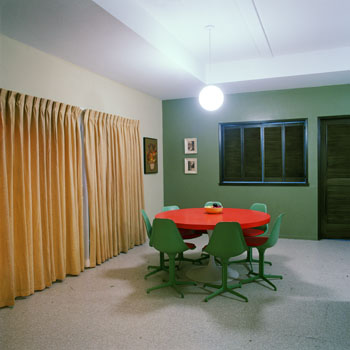|
------JOHN DIVOLA, X-FILES @ PATRICIA
FAURE GALLERY-----
review for Artforum by Jan Tumlir, September 2003
Early in his career John Divola gained public recognition with a suite
of photographs titled Zuma 1978-79, a set of interior views of an old
beachfront property with a single, central window opening onto the Pacific,
like a picture within a picture. In a highly picturesque manner, Divola
recorded the house's gradual destruction at the hands of local vandals,
occasionally joining his own marks to theirs, thereby bringing into question
the documentary status of the undertaking. In this project, all of the
component parts of his practice were already in place: the mise-en-abyme
structure, the tendency to skirt the borders of fiction and the real,
and the simultaneously ironic and earnest suggestion of something beyond
what is, and what can be, known..
If there's is something covertly cinematic about this early project -
its black-box configuration, the regressive pull of its "narrative,"
- Divola's recent exhibition of photographs of television and film sets
brings these ideas out in the open. "Artificial Landscapes, 2002"
is a tight grid of thirty-six black-and-white "continuity shots"
(photos taken by studios to record the state of their sets from one day
of filming to the next) depicting markedly hand-fabricated forest scenes.
By framing them like fine art, and then combining them into a larger ensembles,
Divola submits these "industry" photographs to an acutely reflexive
meta-reading that is as much about what they essentially or materially
consist of as about what they must, by necessity, leave out. Originally
taken to aid the seamless flow of montage, the photographs are, in themselves,
documents of its rupture. Even more paradoxically, perhaps, the photographic
process, miniaturizing and crystallizing every detail of these man-made
worlds, cuts to the quick of filmic fascination. Because the fakeness
of these images is so sharply rendered, one enters each one as a densely
tangled source, a mother lode, of the fantastic and the imaginary.
During the production of the final season of "The X-Files" (January
to April, 2002), Divola gained access to the set and produced a series
of pointedly forensic interiors of FBI offices, a 60's-style home, and
several accompanying still-lives. In this work - this time Divola's own
- a bright, bureaucratic sheen prevails; every line is straight and sharp,
in marked contrast to the shadowy, primeval curlicues that fill out the
forest scenes. But both photographed sites are made of the same illusory
stuff. And besides, "the truth is out there" - meaning, it's
not here. Perhaps "the truth" is in the enfolding darkness against
which Mulder’s and Dogget’s offices can erect only the flimsiest
hedge.
The Brechtian interplay between these two types of photographs would be
enough to carry the show. The convulsive alternations of point of view
(between an exterior made inside and an interior made outside, between
a documentary photograph of an openly constructed fantasy and an openly
constructed photograph of simulated regularity) are vertigo-inducing -
but that's not all. More here than in any previous body of work, Divola
deployed his photographic apparatus in a most orthodox manner - truly
as if to conduct a search of the premises. The X-Files set becomes a kind
of crime scene without ever ceasing to be essentially a pictorial construct.
The clues that Divola uncovers are, accordingly, aesthetic ones. As an
element within a composition, however, the trace of a hand brushed across
a dusty lampshade or the arbitrary confluence of the blue blouse of a
murder victim and the blue tape that holds up her image begin to thrum
with an otherworldly energy.
Link to X-File Images
|
|
